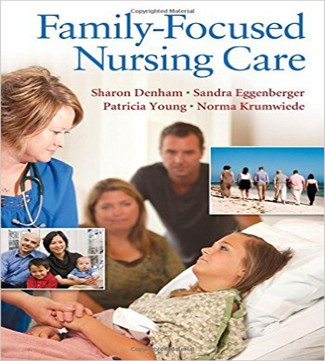Family Focused Nursing Care 1st Edition Denham Eggenberger Young Krumwiede Test Bank
$35.00
Family Focused Nursing Care 1st Edition Denham Eggenberger Young Krumwiede Test Bank
ISBN-10: 0803629109
ISBN-13: 9780803629103 978-0803629103
Chapter 3- Moving to Family-Focused Care
MULTIPLE CHOICE
1. Which of the following does not contribute to the high costs of medical care in the last year of life?
1. Caring for severe illness
2. Functional impairment
3. Nursing home expenditures
4. Over-prescribing practices
ANS: 4
Rationale:
According to Hogan (2001), caring for severe illness, functional impairment, and nursing home expenditures contribute to the high cost of medical care in the last year of life.
PTS: 1
KEY: Content Area: Differentiate among terms like healthy, unhealthy, and societal health | Integrated Process: Caring | Client Need: Physiological Integrity | Cognitive Level: Knowledge | Question Type: Multiple Choice
2. What percent of U.S. adults are overweight or obese?
1. Less than 25%
2. 34%
3. 40%
4. More than 50%
ANS: 2
Rationale:
The obesity crisis is of great concern. According to the Centers for Disease Control and Prevention (2011), about 33.8% of U.S. adults are overweight or obese.
PTS: 1
KEY: Content Area: Differentiate among terms like healthy, unhealthy, and societal health | Integrated Process: Nursing Process | Client Need: Physiological Integrity | Cognitive Level: Knowledge | Question Type: Multiple Choice
3. Consider the following statements:
Statement A. When physicians discuss end-of-life with cancer patients, their health-care costs are much higher in the last week of life.
Statement B. Many dying persons never get referred to hospice care.
1. Both statements A and B are true.
2. Both statements A and B are false.
3. Statement A is true and statement B is false.
4. Statement A is false and statement B is true.
ANS: 4
Rationale:
According to Zhang et al. (2009), costs are much lower when physicians discuss end-of-life care with their patients. Yet many dying persons are never referred to hospice. More than a third of those referred only spend seven days enrolled, although many would benefit greatly from aspects of care management lasting longer (Jennings, Ryndes, D’Onofrio, & Baily, 2010).
PTS: 1
KEY: Content Area: Differentiate among terms like healthy, unhealthy, and societal health | Integrated Process: Nursing Process | Client Need: Safe and Effective Care Environment | Cognitive Level: Knowledge | Question Type: Multiple Choice
4. An ____ point of view encourages one to see connections between society and individual or societal health.
1. Educated
2. Ecumenical
3. Ecological
4. Environmental
ANS: 3
Rationale:
An ecological point of view encourages one to see connections between society and individual or societal health.
PTS: 1
KEY: Content Area: Discuss ways thinking family improves individual, family, and societal health | Integrated Process: Nursing Process | Client Need: Health Promotion and Maintenance | Cognitive Level: Knowledge | Question Type: Multiple Choice
5. How much greater is U.S. health-care spending compared to other nations?
1. About 2.5 times as high
2. About 4 times as high
3. About 7.5 times as high
4. About 10 times as high
ANS: 1
Rationale:
The United States is one of the wealthiest nations in the world and spends more money on health care than anywhere else; health-care spending is about 2.5 times as high as other nations.
PTS: 1
KEY: Content Area: Discuss ways thinking family improves individual, family, and societal health | Integrated Process: Nursing Process | Client Need: Safe and Effective Care Environment | Cognitive Level: Knowledge | Question Type: Multiple Choice
6. Which of the following is not a priority of the Affordable Care Act’s quality improvement strategy?
1. New health-care delivery models.
2. Families engaged as partners in care.
3. Less emphasis on preventive care.
4. Use of best practices.
ANS: 3
Feedback
1 New health-care delivery models, families engaged as partners in care, and use of best practices are all priorities of the Affordable Health Care Act’s quality improvement strategy.
2 New health-care delivery models, families engaged as partners in care, and use of best practices are all priorities of the Affordable Health Care Act’s quality improvement strategy.
3 Rather than less emphasis on preventive care, a priority is to promote the most effective prevention and treatment practices for leading causes of mortality.
4 New health-care delivery models, families engaged as partners in care, and use of best practices are all priorities of the Affordable Health Care Act’s quality improvement strategy.
PTS: 1
KEY: Content Area: Discuss ways thinking family improves individual, family, and societal health | Integrated Process: Nursing Process | Client Need: Safe and Effective Care Environment | Cognitive Level: Knowledge | Question Type: Multiple Choice
MULTIPLE RESPONSE
1. Which of the following may prevent illness?
1. Adequate sleep
2. Early diagnosis
3. Stress management
4. Adequate nutrition
ANS: 1, 3, 4
Rationale:
Adequate sleep, nutrition, and stress management help to prevent illness. Early diagnosis of illness is important too, but it does not prevent illness.
PTS: 1
KEY: Content Area: Identify various perspectives linked with health and illness | Integrated Process: Nursing Process | Client Need: Health Promotion and Maintenance | Cognitive Level: Knowledge | Question Type: Multiple Response
2. Which of the following increase risk for illness?
1. Physical activity
2. Tobacco use
3. Sedentary lifestyle
4. Poverty
ANS: 2, 3, 4
Rationale:
Tobacco use and a sedentary lifestyle are high-risk behaviors; socioeconomic status also correlates with increased risk for illness.
PTS: 1
KEY: Content Area: Identify various perspectives linked with health and illness | Integrated Process: Nursing Process | Client Need: Health Promotion and Maintenance | Cognitive Level: Knowledge | Question Type: Multiple Response
3. What do families desire from hospice care?
1. Continuity of care.
2. Comfort for the dying family member.
3. Autonomy for family members.
4. Case management.
ANS: 1, 2, 3, 4
Rationale:
Continuity of care, comfort for the dying family member, autonomy for family members, and case management are all aspects of hospice care.
PTS: 1
KEY: Content Area: Differentiate among terms like healthy, unhealthy, and societal health | Integrated Process: Caring | Client Need: Safe and Effective Care Environment | Cognitive Level: Knowledge | Question Type: Multiple Response
4. Which of the following factors influence societal health?
1. Access to care providers
2. Educational institutions
3. Wealth distribution
4. Respect of human rights
ANS: 1, 3, 4
Rationale:
Access to care providers, distribution of wealth, and respect of human rights all influence the health of society. Educational institutions are not essential for health and wellness.
PTS: 1
KEY: Content Area: Discuss ways thinking family improves individual, family, and societal health | Integrated Process: Nursing Process | Client Need: Health Promotion and Maintenance | Cognitive Level: Comprehension | Question Type: Multiple Response
5. Which of the following are reasons the United States has a growing health disadvantage when compared with peer countries?
1. Uninsured segments of the population
2. High poverty rates
3. An efficient health-care delivery system
4. Lack of care coordination
ANS: 1, 2, 4
Rationale:
Uninsured people, high poverty rates, and lack of care coordination contribute to the growing health disadvantage of the United States, despite it being one of the wealthiest countries and spending more on health care compared to other nations. The U.S. health-care system is not efficient. There is much duplication, yet there are many gaps in care.
PTS: 1
KEY: Content Area: Discuss ways thinking family improves individual, family, and societal health | Integrated Process: Nursing Process | Client Need: Safe and Effective Care Environment | Cognitive Level: Comprehension | Question Type: Multiple Response
6. Which of the following assumptions about the family perspective will guide nursing actions?
1. Family members need full disclosure and clear explanations.
2. Family members are usually afraid of being involved in care.
3. Family confidence influences care giving.
4. Family members have rights and can make choices.
ANS: 1, 3, 4
Rationale:
Assumptions that may help to guide nursing actions include that family members need full disclosure and clear explanations, that their confidence influences care giving, and that they have rights and can make choices. Families are usually comfortable with other family members and want to be involved, but will need information that will enable their involvement.
PTS: 1
KEY: Content Area: Describe ways nurses think family to deliver family focused care | Integrated Process: Nursing Process | Client Need: Psychosocial Integrity | Cognitive Level: Application | Question Type: Multiple Response
7. Which of the following actions by the nurse demonstrate the nurse is thinking family? Susan, a nurse who thinks family:
1. Introduces herself to each of her patients in the acute-care setting.
2. Ensures that family members are not in the room when procedures are done.
3. Practices active listening with all her patients’ visitors.
4. Commends family members for their positive interactions with her patients.
ANS: 3, 4
Rationale:
Thinking family is demonstrated by actively listening to patients’ visitors and commending family members for their positive interactions with patients. Introducing oneself to each patient and ensuring that family members are not in the room when procedures are done only shows concern for the individual, not for the family.
PTS: 1
KEY: Content Area: Describe ways nurses think family to deliver family focused care | Integrated Process: Communication and Documentation | Client Need: Psychosocial Integrity | Cognitive Level: Application | Question Type: Multiple Response
COMPLETION
1. As early as 1995, the American Nurses Association’s Social Policy Statement described ____________________ as a target for nursing care.
ANS: family
PTS: 1
KEY: Content Area: Discuss ways thinking family improves individual, family, and societal health | Integrated Process: Nursing Process | Client Need: Psychosocial Integrity | Cognitive Level: Knowledge | Question Type: Completion
SHORT ANSWER
1. List several influencers of norms or standards regarding health.
ANS:
Age, genetics, geographical region, culture/ethnicity, etc.
PTS: 1
KEY: Content Area: Identify various perspectives linked with health and illness | Integrated Process: Nursing Process | Client Need: Health Promotion and Maintenance | Cognitive Level: Comprehension | Question Type: Short Answer
2. Compare and contrast obesity and malnutrition as public health issues, and describe how families can influence them.
ANS:
Nurses and the general public are often unaware of public health measures that might be used to reverse the obesity epidemic. Some solutions rest outside the health-care industry, but clinicians might make important differences. For example, lifestyle choices, the built environment, leadership capacities, prevention, public policy, and government interventions offer alternative approaches to the obesity problem. Coordinated actions are needed to solve a problem of this magnitude. Nurses that think family can help by looking beyond primary care settings and find ways to address this concern—one of which is to educate families. Malnutrition and starvation are also growing problems, not only for the homeless or the unemployed, but one that is faced daily by families with inadequate incomes. Families often choose between food and other basic needs (e.g., rent, utilities, and medical care). Nurses that think family consider the health and illness of the family units and the larger society, not merely individuals.
PTS: 1
KEY: Content Area: Identify various perspectives linked with health and illness | Integrated Process: Nursing Process | Client Need: Health Promotion and Maintenance | Cognitive Level: Comprehension | Question Type: Short Answer
3. Explain what is meant by this statement of the Royal College of Physicians and Surgeons:
“Societal needs for medical health care have both quantitative and qualitative perspectives.”
ANS:
Quantitative means that the appropriate number, type, and mix of physicians, nurses, or other health-care professionals are available. Qualitative needs have to do with the adequacy of the professionals’ knowledge, skills, attitudes, and willingness to assume the roles needed by diverse societies. Professional competencies needed by population groups are often culturally specific responses to societal needs, social determinants of health, and the burden of illness.
PTS: 1
KEY: Content Area: Discuss ways thinking family improves individual, family, and societal health | Integrated Process: Nursing Process | Client Need: Health Promotion and Maintenance | Cognitive Level: Application | Question Type: Short Answer












Reviews
There are no reviews yet.